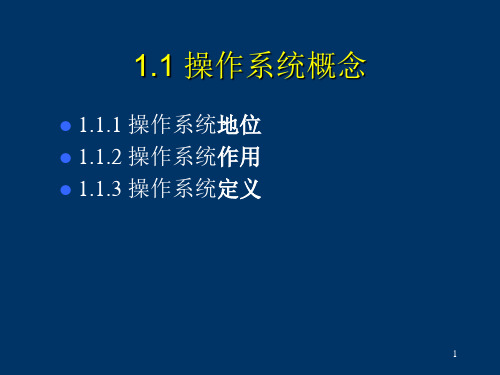重庆大学操作系统PPT3
计算机操作系统第三版全部课件

2.4.2 Windows的命令控制界面
Windows的命令控制界面分为 两个部分: 窗口交互:通过键盘和鼠标在 图形上操作。 命令解释器:通过cmd.exe为 用户服务。
2.4.2 Windows的命令控制界面
图2.6相互调用批处理示例
2.5 系统调用
系统调用分为6类: 1 设备管理 2 文件管理 3 进程控制 4 进程通信 5 存储管理 6 线程管理
1.4.2 分时操作系统(On-line)
HAL
Time Sharing OS
终端
终端
…...
终端
界面1:交互式命令语言(eg. shell, command) 界面2:图形用户界面(GUI)
1.4.2 分时操作系统
• 特点:
– 多路性:一个主机与多个终端相连; – 交互性:以对话的方式为用户服务; – 独占性:每个终端用户仿佛拥有一台虚拟机。
1.1.3 操作系统定义
操作系统是位于硬件层(HAL)之 上,所有其它软件层之下的一个系统 软件,是管理和控制系统中各种软硬 件资源,方便用户使用计算机系统的 程序集合。
Operating supervisor monitoring program
1.2 操作系统的历史
• 操作系统的产生
– 手工操作阶段 – 成批处理阶段 – 执行系统阶段
– 提高处理能力; – 扩展应用领域。
Foreground/Background System
• 常见模式:
– 分时(前台)+批处理(后台) – 实时(前台)+批处理(后台)
1.4.5 单用户操作系统
• 同一时刻仅有一个用户使用的系统 • 应用领域:
– 台式机,笔记本,…….
操作系统 全书课件完整版ppt全套教学教程最全电子教案电子讲义(最新)

即上一条指令的执行结束是下一条指 令执行开始的充分必要条件,程序总 是严格按照给定的指令序列顺序执行 的。即使要改变执行顺序,也是通过 程序本身的指令(如转移指令、循环 指令等)来实现的。
返回
程序一旦开始运行,就必然独占所有 的系统资源,其执行结果由给定的初 始条件决定,而不会受到外界因素的 影响。
2
4 Getdata
3 取数据失败
2
1
1
(a)
(b)
(c)
在某些情况下,程序的并发执行会使得程序顺序执 行时本应具有的封闭性和可再现性遭到破坏,造成 程序运行的结果出现错误。
返回
第三章 作业管理
第三章 作业管理
1、作业与作业步 2、用户界面 3、交互式作业与批处理作业 4、作业调度 5、作业的实例
系统为了保证操作系统的安全及程序运行的正常,系统通常 设置二种机器状态:管态和目态 当操作系统程序运行时,机器处于管态; 当用户程序运行时,机器处于目态。 它们是可以改变的。因此,用户想在自己的程序中调用操作 系统的子功能,就必须改变机器的状态。此时就必须要用到 一种特殊的调用方式:访管方式。为了实现这种调用,系统 提供一条自愿进管指令(访管指令),当CPU执行到这条指令 时就发生中断,称为自愿进管中断(访管中断),它表示正 在运行的程序对操作系统提出某种要求。此时就可以改变机 器的状态,即由目态转为管态。为了使控制能跳到用户当前 所需要的那个例行子程序去,就需要指令提供一个地址码, 用这个地址码表示系统调用的功能号。它也是操作系统提供 的例行子程序的编号。然后在访管指令中输入相应的号码, 以完成用户当前所需要的服务。因此,一个带有一定功能号 的访管指令就定义了一条系统调用命令。它不由硬件来直接 提供,而是由软件来实现的,也可说是由操作系统中的某段 程序来实现的。亦可称为广义指令或系统宏指令。
操作系统概述PPT课件精选全文

1.1.1 操作系统地位 1.1.2 操作系统作用 1.1.3 操作系统定义
1
1.1.1 操作系统地位
硬件抽象层(HAL)之上 所有其它软件层之下
应用软件层
其它系统软件层 OS
硬件(HAL)
注意, 上图所示的层次关系具有穿透性:高层软件可调用 所有低于所在层次的软件,并可与硬件直接打交道。
—— API、GUI (Graphic User Interface) 4
1.1.3 操作系统定义
操作系统是位于硬件层(HAL)之上、所有 其它软件层之下的一个系统软件,是管 理系统中各种软硬件资源、方便用户使 用计算机系统的程序集合。
5
1.2 操作系统的历史
1.2.1 操作系统的产生
– 手工操作阶段 – 成批处理阶段 – 执行系统阶段
1.2.2 操作系统的完善
– 多道批处理系统 – 分时系统 – 实时处理系统 – 通用操作系统
1.2.3操作系统的发展
– 网络操作系统 – 分布式操作系统 – 多处理机操作系统 – 单用户操作系统 – 面向对象操作系统 – 嵌入式操作系统 – 智能卡操作系统
6
1.2.1 操作系统的产生
一、手工操作阶段 (20世纪40道批处理操作系统(batch processing system) 分时操作系统(time-sharing system) 实时操作系统(real-time system) 通用操作系统(multi-purpose system) 单用户操作系统(single user system) 网络操作系统(network operating system) 分布式操作系统(distributed operating system) 多处理机操作系统(multi-processor system) 嵌入式操作系统(embedded operating system) 智能卡操作系统(smart-card operating system)
《操作系统》ppt课件

进程转换
就绪→执行、执行→就绪、 执行→阻塞、阻塞→就绪。
进程控制
创建进程、终止进程、进 程阻塞与唤醒、进程切换。
进程控制块PCB
PCB概念
进程控制块是系统为了管理进程而设 置的一个专门的数据结构,用它来记 录进程的外部特征,描述进程的运动 变化过程。
PCB内容
PCB作用
使一个在多道程序环境下不能独立运 行的程序(含数据),成为一个能独 立运行的基本单位,一个能与其他进 程并发执行的进程。
02
强制访问控制
系统对用户和文件实行强制性的 访问控制,如军事领域的多级安 全保护。
03
基于角色的访问控 制
根据用户在系统中的角色来分配 访问权限,实现企业中的权限管 理。
加密技术在操作系统中应用
文件加密
对重要文件进行加密存储,防止未经授权的用户 访问。
磁盘加密
对整个磁盘或磁盘分区进行加密,保护磁盘数据 的安全性。
设备驱动程序设计
设备驱动程序的功能
实现与硬件设备的通信和控制,向上层软件提供统一的接口。
设备驱动程序的组成
包括设备服务例程、中断处理程序和设备管理策略等。
设备驱动程序的编写
需要了解硬件设备的特性和接口规范,采用适当的编程语言和开发工具进行编写。
设备驱动程序的调试与测试
通过调试和测试确保设备驱动程序的正确性和稳定性。
磁盘调度算法比较
先来先服务(FCFS)
按照请求到达的先后顺序进行服务,简单但效率不高。
最短寻道时间优先(SSTF)
优先选择距离当前磁头位置最近的请求进行服务,可减少磁头移动距 离,但可能导致某些请求长时间等待。
扫描算法(SCAN)
磁头从一端向另一端移动,途中满足遇到的请求,到达另一端后返回, 途中再次满足遇到的请求,如此往复。
2024年度《计算机操作系统》教学课件合集pptx

2024/3/23
16
文件组织结构设计
01
逻辑结构
文件的逻辑结构是用户可见的结构,包括流式文件和记录式文件两种基
本形式。
02
物理结构
文件的物理结构是操作系统在磁盘上存储文件的方式,包括连续分配、
链接分配和索引分配三种基本形式。
2024/3/23
03
逻辑结构与物理结构的关系
文件的逻辑结构是用户可见和使用的结构,而物理结构是操作系统管理
错误处理
当用户在执行多任务时遇到错误或冲突,系统应提供有效的错误处理 机制,如错误提示、撤销操作等,帮助用户及时解决问题。
26
07
安全性与保护机制
2024/3/23
27
操作系统安全性要求
01
保密性
确保用户数据和系统信息不被未经 授权的人员获取。
可用性
确保系统和数据在需要时可用,不 因恶意攻击或错误而中断。
2024/3/23
03
内存管理
11
内存空间分配方式
03
连续分配方式
非连续分配方式
分配算法
单一连续分配、固定分区分配、动态分区 分配
基本分页存储管理、基本分段存储管理、 段页式存储管理
首次适应算法、最佳适应算法、最坏适应 算法
2024/3/23
12
虚拟内存技术原理
1 2
虚拟内存的基本概念
程序员用到的内存空间为虚拟内存,实际用到的 内存空间为物理内存
动态分配策略
根据设备的请求和系统的状态,动态地分配设备给需要的进程或任 务。这种策略可以提高设备的利用率和系统的灵活性。
分配算法
常用的设备分配算法包括先来先服务(FCFS)、最短作业优先(SJF )、优先级调度等。
计算机操作系统PPT课件

将内存页面组织成环形链表,通过指针循环扫描选择可置换的页面, 实现简单且性能适中。
内存保护机制设计
01
界限寄存器保护
为每个进程分配一个界限寄存器,规定其访问的内存范围,防止进程越
界访问其他进程的内存空间。
02 03
基址寄存器和限长寄存器保护
将进程的逻辑地址空间映射到物理地址空间上,通过基址寄存器和限长 寄存器实现内存保护。基址寄存器存放进程在内存中的起始地址,限长 寄存器存放进程的长度。
拒绝服务攻击
通过大量请求拥塞网络或耗尽系统资源,使合法用户无法 正常使用服务。
身份认证和访问控制策略
1 2
身份认证机制
通过用户名、密码、生物特征等方式验证用户身 份,确保只有合法用户能访问系统。
访问控制列表(ACL)
定义不同用户或用户组对系统资源的访问权限, 实现细粒度的权限控制。
3
角色基于访问控制(RBAC)
文件共享与保护机制
文件共享
多个用户或程序可以同时访问同一个文件,操作系统需要提供文件共享机制。
文件保护
为了防止文件被未经授权的用户或程序访问和修改,操作系统需要提供文件保护机制,如 访问控制列表(ACL)等。
并发控制
当多个用户或程序同时访问同一个文件时,操作系统需要进行并发控制,以确保数据的一 致性和完整性。
虚拟内存技术原理及应用
虚拟内存技术原理
利用磁盘空间作为内存的扩展部分,将部分暂时不用的程序和数据存放到磁盘 上,以便腾出内存空间给急需的程序和数据。当需要再次使用这些程序和数据 时,再从磁盘上读入内存。
虚拟内存技术应用
实现进程的隔离和保护,提高内存利用率,支持多道程序设计和分时系统,使 得大型程序能够在小内存中运行。
计算机操作系统课件完整版

分配算法
首次适应算法、最佳适应 算法、最坏适应算法等, 用于决定如何为进程分配 内存空间。
虚拟内存技术原理及应用
虚拟内存概念
通过硬件和软件的结合 ,将物理内存和外存结 合起来,为用户提供比 实际物理内存大得多的 逻辑内存空间面 置换功能,实现虚拟内 存。
分布式操作系统
这种操作系统能够管理分布在不同地点的 计算机资源,支持分布式计算和协同工作 ,适用于构建和管理分布式系统。
分时操作系统
这种操作系统允许多个用户同时使用计算 机,每个用户都感觉自己独占了整个系统 资源。
网络操作系统
这种操作系统能够管理网络资源,提供网 络服务和支持网络通信,适用于构建和管 理计算机网络。
分布式系统特点和挑战
分布式系统特点
分布式系统由多台计算机组成,每台计算机都拥有独立的处理能 力和存储空间,计算机之间通过网络进行通信和协作。
分布式系统挑战
分布式系统面临着诸多挑战,如数据一致性、并发控制、容错处理 、安全性等。
分布式系统应用
分布式系统广泛应用于云计算、大数据处理、物联网等领域。
典型分布式操作系统案例分析
• 优先级调度策略:优先级调度策略是根据设备请求的优先级进行资源分配。优先级高的请求可以优先获得资源 ,而优先级低的请求则需要等待。这种策略的优点是可以满足紧急或重要请求的需求,但缺点是可能导致低优 先级请求长时间得不到处理。
06
用户界面与交互设计
用户界面基本要素和原则
用户界面基本要素
包括窗口、菜单、图标、按钮等,这些 要素是用户与计算机进行交互的基础。
网络协议栈概述
网络协议栈是一组按照特定层次结构排列的网络协议集合,用于实 现不同计算机系统之间的通信。
2024版年度《计算机操作系统》ppt课件完整版

段式存储管理
2024/2/2
段式存储管理的概念
将作业的地址空间划分为若干个段,每个段定义了一组逻辑信息, 以段为单位进行内存分配。
段式存储管理的地址映射
通过段表将逻辑地址转换为物理地址。
段式存储管理的优缺点
优点是符合程序的逻辑结构,有利于信息共享和保护,缺点是内存 利用率不高,可能产生外部碎片。
作业同步与通信
作业管理界面
协调多个作业之间的运行顺序,实现资源共 享和协同工作。
提供友好的作业管理界面,方便用户进行作 业操作和管理。
2024/2/2
12
03
进程与线程
2024/2/2
13
进程的概念与特征
进程是程序的一次执 行过程,是系统进行 资源分配和调度的基 本单位。
进程由程序、数据和 进程控制块(PCB) 三部分组成。
根据进程需求分配设备资源,如打印机、磁 盘等。
设备独立性
屏蔽不同设备之间的差异,提供统一的设备 接口。
2024/2/2
设备驱动
提供设备控制程序,驱动设备执行操作。
缓冲管理
对输入输出数据进行缓冲,提高设备使用效 率。
10
文件管理
文件存储空间管理
分配和管理文件存储空间,支持文件 的创建、删除等操作。
目录管理
32
设备分配与回收
设备分配原则
先进先出、优先级高者优先等。
设备分配算法
包括静态分配和动态分配,其中 动态分配又包括先来先服务、最
短寻道时间优先等算法。
设备回收
当设备不再被使用时,需要将其 回收以供其他进程使用。
2024/2/2
33
缓冲技术
缓冲的引入原因
解决CPU与外设之间速度不匹配的问题,提高 CPU的利用率。
《操作系统》PPT电子课件教案-2024鲜版

提供缓冲区管理
设备管理的目标
2024/3/27
26
设备管理的功能与目标
方便性
使用户使用设备尽可能方便
均衡性
使CPU与I/O设备负载均衡
2024/3/27
并行性
使CPU与I/O设备并行工作
独立性
使应用程序独立于具体使用的物理设备
27
I/O控制方式
程序I/O方式 CPU与设备串行工作,效率低下。
中断驱动I/O方式
2024/3/27
13
分区存储管理
1 2
分区存储管理的定义 分区存储管理是将内存空间划分为若干个固定大 小的区域,每个区域称为一个分区,每个分区中 可装入一道作业。
分区的划分方法 固定分区和动态分区。
3
分区的分配策略 首次适应算法、最佳适应算法和最坏适应算法等。
2024/3/27
14
页式存储管理
页式存储管理的定义
页式存储管理是将一个进程的逻辑地 址空间划分为若干个大小相等的片, 称为页面或页,并为各页加以编号。 相应地,也把内存空间划分为与页面 相同大小的若干个存储块,称为物理 块或页框,同样加以编号。在为进程 分配内存时,以块为单位将进程中的 若干个页分别装入到多个可以不相邻 接的物理块中。
文件的逻辑结构的分类
包括流式文件、记录式文件。
2024/3/27
20
文件的物理结构
2024/3/27
文件的物理结构
又称文件的存储结构,是指文件在外 存上的存储组织形式。
文件的物理结构的分类
包括连续文件、链接文件、索引文件。
21
文件目录管理
2024/3/27
文件目录的概念
文件目录是记录系统中所有文件的名字及其存放地址的目录表, 表中还包括关于文件的说明信息和控制信息。
计算机操作系统ppt课件

contents •计算机操作系统概述•进程管理•内存管理•文件系统•设备管理•用户界面与交互性支持•网络操作系统简介目录01计算机操作系统概述定义与功能定义管理计算机资源提供用户界面组织计算机工作流程发展历程及分类发展历程分类操作系统与硬件/软件关系与硬件关系与软件关系02进程管理进程概念及状态转换进程定义01进程状态02进程控制块(PCB)03先来先服务(FCFS )优先级调度时间片轮转(RR )短作业优先(SJF )进程调度算法进程同步与通信机制信号量机制消息传递机制管道通信共享内存机制03内存管理内存空间分配方式连续分配方式非连续分配方式允许一个程序分散地装入到不相邻的内存分区中,包括基本分页存储管理、基本分段存储管理和段页式存储管理。
虚拟内存技术原理及应用虚拟内存技术原理虚拟内存技术应用内存保护机制界限寄存器保护访问控制列表硬件保护键04文件系统文件概念及类型划分文件概念文件是计算机中存储数据的基本单位,通常是一组相关数据的集合,可以包含文本、图像、音频、视频等多种形式的数据。
类型划分根据文件的性质和用途,可以将其划分为不同类型,如文本文件、二进制文件、图像文件、音频文件、视频文件等。
文件组织结构文件逻辑结构文件的逻辑结构是指用户从逻辑上看到的文件组织形式,包括流式文件和记录式文件两种。
流式文件以字节为单位进行组织,而记录式文件则以记录为单位进行组织。
文件物理结构文件的物理结构是指文件在存储设备上的存放方法,包括连续文件、串联文件和索引文件三种。
连续文件将文件信息按顺序连续存放在磁盘上;串联文件将文件信息分散存放在磁盘上,通过指针链接;索引文件则通过建立索引表的方式来管理和访问文件。
文件的访问权限是指用户对文件的读、写和执行等操作的许可权。
操作系统通常提供了一套机制来控制不同用户对文件的访问权限,以保障系统的安全性和数据的保密性。
访问权限常见的文件访问权限控制方法包括自主访问控制(DAC )、强制访问控制(MAC )和基于角色的访问控制(RBAC )。
操作系统ppt课件完整版

2024/1/30
10
进程同步与通信
2024/1/30
进程同步
多个进程在执行过程中需要协调其推进速度,以保证它们之 间正确的协作关系。进程同步的主要任务是使并发执行的诸 进程之间能有效地共享资源和相互合作,从而使程序的执行 具有可再现性。
进程通信
进程通信是指进程之间的信息交换。在分布式系统中,进程 通信是实现分布式计算和协同工作的基础。常见的进程通信 方式包括管道(pipe)、消息队列(message queue)、信 号(signal)等。
2024/1/30
9
进程调度算法
调度算法的分类
根据调度策略的不同,进程调度算法可分为先来先服务(FCFS)、短作业优先( SJF)、优先级调度(Priority Scheduling)、时间片轮转(RR)等。
调度算法的选择
在选择调度算法时,需要考虑系统的整体性能、资源利用率、响应时间等因素。 不同的调度算法适用于不同的应用场景和需求。
将程序的逻辑地址空间划分为固定大小的页,而物理内存划分为同样大 小的页框。程序加载时,可将任意一页放入内存中任意一个页框,实现 离散分配。
页表
记录逻辑页与物理页框的对应关系。
2024/1/30
03
优缺点
提高了内存利用率,减少了碎片;但增加了系统开销,可能产生抖动现
象。
15
段式存储管理
基本思想
把程序按内容或过程(函数)关 系分成段,每段有自己的名字。 一个用户作业或进程所包含的段 对应于一个二维线性虚拟空间,
即一个段表。
段表
记录各段在内存中的起始地址和 段的长度。
优缺点
便于实现共享和保护;但容易产 生碎片,浪费内存空间。
大学计算机基础操作系统基础-----教材配套-PPT课件

应用程序图标; 通过“开始”菜单启动应用程序; 通过浏览驱动器和文件夹启动应用程序; 创建应用程序的快捷方式; 使用“开始”菜单中的“运行”命令启动应 用程序。
4.启动和退出应用程序 (2)退出应用程序
选择文件菜单上关闭命令; 双击控制菜单框; 单击控制菜单框,在弹出的控制菜单上选 择关闭命令; 单击关闭按钮; 按Alt+F4; “任务管理器” 中,选中要关闭的应用程 序再单击“结束任务”按钮。
什么是桌面?
桌面是Windows XP启动后进入的第一个可 操作界面
“开始”按钮和“任务栏” “开始”按钮是运行Windows XP应用程序入 口。 单击“开始”按钮,打开“开始”菜单,它包 含了使用Windows XP所需的全部命令
“Windows资源管理器”:是浏览本地、网络、 Intranet或Internet上的资源的最有效的工具 “我的电脑”:可以查看计算机上的所有内容, 包括文件和文件夹。 “网上邻居”:通过“网上邻居”可浏览网络上 的计算机。 “Microsoft Internet Explorer”:浏览器 回收站:用来存放用户删除的文件 “收件箱”图标:存储了其他计算机用户发送来 的电子邮件
3.Windows XP的启动和退出
Windows XP的启动 Windows XP的关闭 单击“开始”按钮,在弹出的菜单中选择“关机”命令 按Alt+F4键
关闭Windows XP对话框
2.2.2 Windows XP的基本知识和基本操 作
1. Windows XP桌面简介
2. Windows XP中文版的窗口和对话框
操作系统-完整版PPT课件

B、双击“标题栏”
C、单击“任务栏”上相应的“任务按钮”
D、选择“控制”按钮弹出菜单中的“”最 大化
选项
2、在Windows中,可以“关闭”窗
口的操作是A(BCD
)
A、双击“控制”按钮
B、按ALT+F4
C、选择文件“下拉菜单的”关闭“ 选项
D、选择“控制”按钮弹出菜单中“ 关闭”选项
3、属于多用户多任务的操作系统的是 ( BCD )
操作中,要先按住键盘上的( A )键 ,再依次单击各选择对象。
A.CTRL B.ALT
C.SHIFT D.TAB
6、在Windows98中,有些菜单的选项
中的右端有一个向右的箭头,则表示 该菜单项代表( A )
A.将弹出下一级子菜单 B.当前不能选取执行 C.已被选中 D.将弹出一个对话框
7、应用程序窗口最大化以后,标
A.该命令正在使用
B.当前不能选取执行
C.执行该命令时出错
D.该命令已正确执行
3、按组合键( B )可以打开“开始 ”菜单。
A. Ctrl+O C. Ctrl+空格键
B. Ctrl+Ese D. Ctrl+Tab
4、运行windows98桌面上已经有某应用 程序的图标,可以( B )
A.左键单击该图标 B.左键双击该图标 C.右键单击该图标 D.右键双击该图标 5、在选定多个非连续文件或文件夹的
题栏右边分别是( B )三个 按钮 A.最小化、最大化和大小 B.最小化、还原和关闭 C.最小化、关闭和移动 D.最小化、最大化和恢复
8、下列叙述中,正确的是( D )
A、“开始”菜单只能用鼠标单击“开始” 按钮才能打开
操作系统ppt

硬件资源:
CPU,内存,外部设备(I/O设备,外存, 时钟,网络接口等)
软件资源:
硬盘上的文件,信息
管理资源
记录资源使用状况
如 哪些资源空闲,好坏与否,被谁使用,使用多长时间 等
合理的分配资源
静态分配策略 (在程序运行前分配,但效率不高) 动态分配策略 (在程序运行过程中何时用资源,何时分配。其缺点是会出现
进程通信:进程之间传送数据,以协调进程间的协作; --交换信息能力强,也可以用来协调进程之间的推进
进程调度:作业和进程的运行切换,以充分利用处理机 资源和提高系统性能;--未必是进程控制操作所引起 (可能是时间片轮转、I/O操作)
同一类型内的公平性、高效率(吞吐量大)、作业周转 时间等
存储管理
第1章 操作系统概论
第1章 操作系统概论
• 操作系统的概念 • 操作系统的基本特性 • 研究操作系统的几种观点 • 操作系统的发展过程 • 著名的操作系统 • 操作系统的分类 • 操作系统的功能
一、操作系统的目标与作用
计算机系统由硬件和软件组成 操作系统在硬件基础上的第一层软件 是其他软件和硬件之间的接口
推动操作系统发展的主要动 力
不断提高计算机资源利用率的需要 方便用户 器件的不断更新换代 计算机体系结构的不断发展
无操作系统的计算机系统
(1)人工操作方式
工作流程:
(1)由程序员事先穿孔(对应程序和数据) (2)将穿孔的纸带(卡片)装入纸带(卡片)输入机 (3)再启动输入机将程序和数据输入计算机, (4)然后启动计算机运行 (5)运行完毕取走计算机结果 (6)下一位用户
操作系统的作用(1)
OS作为用户/软件与计算机硬件系统之间的接口
【重庆大学本科四门专业课PPT】操作系统Chapter02

Job Control Language
• Special type of programming language • Provides instruction to the monitor
– What compiler to use – What data to use
desirable Hardware Features
Chapter 2 Operating System Overview
Operating System
• A program that controls the execution of application programs • An interface between applications and hardware • three objectives
Services Provided by the OS
• Accounting
– Collect usage statistics – Monitor performance – Used to anticipate future enhancements – Used for billing purposes
– An executable program – Associated data needed by the program – Execution context of the program
• All information the operating system needs to manage the process
Services Provided by the OS
• Error detection and response
– Internal and external hardware errors – Software errors – Operating system cannot grant request of application
- 1、下载文档前请自行甄别文档内容的完整性,平台不提供额外的编辑、内容补充、找答案等附加服务。
- 2、"仅部分预览"的文档,不可在线预览部分如存在完整性等问题,可反馈申请退款(可完整预览的文档不适用该条件!)。
- 3、如文档侵犯您的权益,请联系客服反馈,我们会尽快为您处理(人工客服工作时间:9:00-18:30)。
• Concurrent execution
Process
What is Process
• A program in execution • An instance of a program running on a computer • The entity that can be assigned to and executed on a processor • A unit of activity characterized by the execution of a sequence of instructions, a current state, and an associated set of system resources
User Processes in Virtual Memory (structure of process images)
Elements of a Process Control Block
• Process Identification
– Identifiers • Identifier of this process • Identifier of the process that created this process (parent process) • User identifier
PROCESS CONTROL
Modes of Execution
• User mode
– Less-privileged mode – User programs typically execute in this mode
•
•
A Five-State
Parent request / termination
Parent request / termination
A Five-State Model
A Five-State Model
A Five-State Model
A Five-State Model
Process Control Structures
• Process image is the collection of program, Data, stack, and attributes (process control block)
The Role of the Process Control Block
• I/O Tables
– I/O device is available or assigned – Status of I/O operation – Location in main memory being used as the source or destination of the I/O transfer
Process Trace
Process Trace
Process Trace
Two-State Process Model
• Process may be in one of two states
– Running – Not-running
Two-State Process Model
–
•
Process Control Information
–
– – – – –
The Role of the Process Control Block
• Each process control block contains all of the information about a process that is needed by the OS. • One can say that the set of process control blocks defines the state of the OS.
•
Processor State Information
– – User-Visible Registers Control and Status Registers • Program counter • Condition codes • Status information Stack Pointers
Chapter 3 Process Description and Control
The way of program execution
• Serial execution
– Multiple programs to be executed sequentially, one by one
• Parallel execution
Process States
Process Trace
• The instruction sequence of process to be executed---- Process Trace • We can characterize behavior of the processor by showing how the traces of the various processes are interleaved.
Process Termination
A Five-State Model
A Five-State Model
• New: A process that has just been created but
• •
has not yet been admitted to the pool of executable processes by the OS. Ready: A process that is prepared to execute when given the opportunity. Running: The process that is currently being executed. Blocked: A process that cannot execute until some event occurs. Exit: A process that has been released from the pool of executable processes by the OS.
Operating System Control Structures
• Memory Tables
– Allocation of main memory to processes – Allocation of secondary memory to processes – Protection attributes for access to shared memory regions – Information needed to manage virtual memory
• Information about the current status of each process and resource • Tables are constructed for each entity the operating system manages
Operating System Control Structures
Process Creation
When one process spawns another, the former is referred to as the parent process, and the spawned process is referred to as the child process.
A Five-State Model
• Priority Queue
– If the dispatching of processes is dictated by a priority scheme, then it would be convenient to have a number of Ready queues, one for each priority level. The OS could then readily determine which is the highest-priority ready process that has been waiting the longest.
Suspended Processes
Process Description
Process Description
• What information does the OS need to control processes and manage resources for them?
Operating System Control Structures
Process Control Block
• Identifier: A unique identifier • State: Process state, such as running • Priority • Program counter: The address of the next instruction • Memory pointers: pointers to the program code and data • Context data: data in registers • I/O status information: I/O requests, I/O devices, file list, and so on. • Accounting information
Suspended Processes
• Processor is faster than I/O, so all processes could be waiting for I/O • Some of processes are swapped out of main memory to free up more memory
